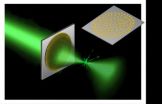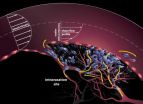(Press-News.org) Cambridge, Mass. – August 23, 2012 – Applied physicists at the Harvard School of Engineering and Applied Sciences (SEAS) have created an ultrathin, flat lens that focuses light without imparting the distortions of conventional lenses.
At a mere 60 nanometers thick, the flat lens is essentially two-dimensional, yet its focusing power approaches the ultimate physical limit set by the laws of diffraction.
Operating at telecom wavelengths (i.e., the range commonly used in fiber-optic communications), the new device is completely scalable, from near-infrared to terahertz wavelengths, and simple to manufacture. The results have been published online in the journal Nano Letters.
"Our flat lens opens up a new type of technology," says principal investigator Federico Capasso, Robert L. Wallace Professor of Applied Physics and Vinton Hayes Senior Research Fellow in Electrical Engineering at SEAS. "We're presenting a new way of making lenses. Instead of creating phase delays as light propagates through the thickness of the material, you can create an instantaneous phase shift right at the surface of the lens. It's extremely exciting."
Capasso and his collaborators at SEAS create the flat lens by plating a very thin wafer of silicon with an nanometer-thin layer of gold. Next, they strip away parts of the gold layer to leave behind an array of V-shaped structures, evenly spaced in rows across the surface. When Capasso's group shines a laser onto the flat lens, these structures act as nanoantennas that capture the incoming light and hold onto it briefly before releasing it again. Those delays, which are precisely tuned across the surface of the lens, change the direction of the light in the same way that a thick glass lens would, with an important distinction.
The flat lens eliminates optical aberrations such as the "fish-eye" effect that results from conventional wide-angle lenses. Astigmatism and coma aberrations also do not occur with the flat lens, so the resulting image or signal is completely accurate and does not require any complex corrective techniques.
The array of nanoantennas, dubbed a "metasurface," can be tuned for specific wavelengths of light by simply changing the size, angle, and spacing of the antennas.
"In the future we can potentially replace all the bulk components in the majority of optical systems with just flat surfaces," says lead author Francesco Aieta, a visiting graduate student from the Università Politecnica delle Marche in Italy. "It certainly captures the imagination."
INFORMATION:
Aieta's and Capasso's coauthors at SEAS included postdoctoral research associates Patrice Genevet and Nanfang Yu (Ph.D. '09), graduate students Mikhail A. Kats and Romain Blanchard, and visiting scholar Zeno Gaburro.
The work was supported by the National Science Foundation (NSF), the NSF-funded Harvard Nanoscale Science and Engineering Center, and the Center for Nanoscale Systems at Harvard (a member of the NSF-supported National Nanotechnology Infrastructure Network). The researchers also individually received support from the Robert A. Welch Foundation, the European Communities Seventh Framework Programme, and an NSF Graduate Research Fellowship.
Flat lens offers a perfect image
Ultrathin wafer of silicon and gold focuses telecom wavelengths without distortion
2012-08-24
ELSE PRESS RELEASES FROM THIS DATE:
IBN develops superior fuel cell material
2012-08-24
Singapore, August 24, 2012 – Using a mixture of gold, copper and platinum nanoparticles, IBN researchers have developed a more powerful and longer lasting fuel cell material. This breakthrough was published recently in leading journal, Energy and Environmental Science.
Fuel cells are a promising technology for use as a source of electricity to power electronic devices, vehicles, military aircraft and equipment. A fuel cell converts the chemical energy from hydrogen (fuel) into electricity through a chemical reaction with oxygen. A fuel cell can produce electricity continuously ...
Most mutations come from dad
2012-08-24
Humans inherit more than three times as many mutations from their fathers as from their mothers, and mutation rates increase with the father's age but not the mother's, researchers have found in the largest study of human genetic mutations to date.
The study, based on the DNA of around 85,000 Icelanders, also calculates the rate of human mutation at high resolution, providing estimates of when human ancestors diverged from nonhuman primates. It is one of two papers published this week by the journal Nature Genetics as well as one published at Nature that shed dramatic ...
Survival statistics show hard fight when malignant brain tumors appear at multiple sites
2012-08-24
LOS ANGELES (Embargoed until 10 a.m. EDT on Aug. 24, 2012) – When aggressive, malignant tumors appear in more than one location in the brain, patient survival tends to be significantly shorter than when the disease starts as a single tumor, even though patients in both groups undergo virtually identical treatments, according to research at Cedars-Sinai Medical Center's Maxine Dunitz Neurosurgical Research Institute.
"We've known that certain independent factors, such as age at diagnosis, amount of residual tumor after surgery, and the patient's functional status are useful ...
Bigger creatures live longer, travel farther for a reason
2012-08-24
DURHAM, N.C. -- A long-standing mystery in biology about the longer lifespans of bigger creatures may be explained by the application of a physical law called the Constructal Law (www.constructal.org).
What this law proposes is that anything that flows -- a river, bloodstream or highway network -- will evolve toward the same basic configuration out of a need to be more efficient. And, as it turns out, that same basic law applies to all bodies in motion, be they animals or tanker trucks, says Adrian Bejan, the J.A. Jones Professor of mechanical engineering at Duke and ...
New model gives hands-on help for learning the secrets of molecules
2012-08-24
For biology researchers, the complex world of molecular proteins – where tens of thousands of atoms can comprise a single protein – may be getting clearer with the help of a new soft, transparent, and squishy silicone model they can hold in their hands. Its advantage over traditional computer and solid models is that it is mostly transparent and easy to manipulate, which will help researchers more intuitively understand protein structures, positions, and interactions. The models will enable researchers to quickly and collaboratively see, touch, and test ideas about molecular ...
Modeling metastasis
2012-08-24
Cancer metastasis, the escape and spread of primary tumor cells, is a common cause of cancer-related deaths. But metastasis remains poorly understood. Studies indicate that when a primary tumor breaks through a blood vessel wall, blood's "stickiness" tears off tumor cells the way a piece of tape tears wrapping paper. Until now, no one knew the physical forces involved in this process, the first step in metastasis. Using a statistical technique employed by animators, scientists created a new computer simulation that reveals how cancer cells enter the bloodstream. The researchers ...
The end of an era? Branding horses does not enable them to be identified
2012-08-24
There are many reasons why it is important to be able to identify farm animals, horses and small companion animals. Unique identification marks are essential for ensuring the correctness of breeding programmes, for preventing the spread of disease and for eliminating the possibility of deceit in competitions or when animals are sold. The traditional method of marking larger farm animals relies on branding with hot irons or on ear-tagging but this is deemed inappropriate for use on dogs and cats, which are identified by the implant of a microchip transponder. Until recently, ...
Astrocytes control the generation of new neurons from neural stem cells
2012-08-24
Astrocytes are cells that have many functions in the central nervous system, such as the control of neuronal synapses, blood flow, or the brain's response to neurotrauma or stroke.
Reduces brain tissue damage
Prof. Pekny's laboratory together with collaborators have earlier demonstrated that astrocytes reduce the brain tissue damage after stroke and that the integration of transplanted neural stem cells can be largely improved by modulating the activity of astrocytes.
Generation of new neurons
In their current study, the Sahlgrenska Academy researchers show how astrocytes ...
Researchers describe new molecular interactions behind the inhibition of TGF beta-signaling
2012-08-24
This press release is available in Spanish.
Researchers headed by Maria Macias an ICREA researcher at the Institute for Research in Biomedicine (IRB Barcelona) and Joan Massagué, a Howard Hughes Medical Institute investigator at Memorial Sloan-Kettering Cancer Center (MSKCC) in New York, have identified a new molecular mechanism that plays a crucial role in the control of the activation of certain genes associated with cancer.
Through detailed structural and biochemical studies, the researchers identified a key domain present in a family of proteins called Smads, whose ...
Southampton physicists join search for hidden magnetic states
2012-08-24
Physicists from the University of Southampton were among the first researchers to use the new high magnetic-field beamline at Diamond Light Source, the UK's national synchrotron facility, to search for 'hidden magnetic states'.
If found, they will provide important confirmation of a theoretical model, which could have important applications in magnetic data storage.
Diamond's new I10 Beamline for Advanced Dichroism Experiments (BLADE) beamline, which has 300,000 times the strength of the earth's magnetic field, is providing them with the tools for the search. The beamline ...
LAST 30 PRESS RELEASES:
Low daily alcohol intake linked to 50% heightened mouth cancer risk in India
American Meteorological Society announces Rick Spinrad as 2026 President-Elect
Biomass-based carbon capture spotlighted in newly released global climate webinar recording
Illuminating invisible nano pollutants: advanced bioimaging tracks the full journey of emerging nanoscale contaminants in living systems
How does age affect recovery from spinal cord injury?
Novel AI tool offers prognosis for patients with head and neck cancer
Fathers’ microplastic exposure tied to their children’s metabolic problems
Research validates laboratory model for studying high-grade serous ovarian cancer
SIR 2026 delivers transformative breakthroughs in minimally invasive medicine to improve patient care
Stem Cell Reports most downloaded papers of 2025 highlight the breadth and impact of stem cell research
Oxford-led study estimates NHS spends around 3% of its primary and secondary care budget on the health impacts of heat and cold in England
A researcher’s long quest leads to a smart composite breakthrough
Urban wild bees act as “microbial sensors” of city health.
New study finds where you live affects recovery after a hip fracture
Forecasting the impact of fully automated vehicle adoption on US road traffic injuries
Alcohol-related hospitalizations from 2016 to 2022
Semaglutide and hospitalizations in patients with obesity and established cardiovascular disease
Researchers ‘listen in’ to embryo-mother interactions during implantation using a culture system replicating the womb lining
How changing your diet could help save the world
How to make AI truly scalable and reliable for real-time traffic assignment?
Beyond fragmented markets: A new framework for efficient and stable ride-pooling
Can shape priors make road perception more reliable for autonomous driving?
AI tracks nearly 100 years of aging research, revealing key trends and gaps
Innovative techniques enable Italy’s first imaging of individual trapped atoms
KIER successfully develops Korea-made “calibration thermoelectric module” for measuring thermoelectric device performance
Diversifying US Midwest farming for stability and resilience
Emphasizing immigrants’ deservingness shifts attitudes
Japanese eels, climate change, and river temperature
Pusan National University researchers discover faster, smarter heat treatment for lightweight magnesium metals
China’s 2024 Gastroenterology Report: marked progress in endoscopy quality and disease management
[Press-News.org] Flat lens offers a perfect imageUltrathin wafer of silicon and gold focuses telecom wavelengths without distortion





